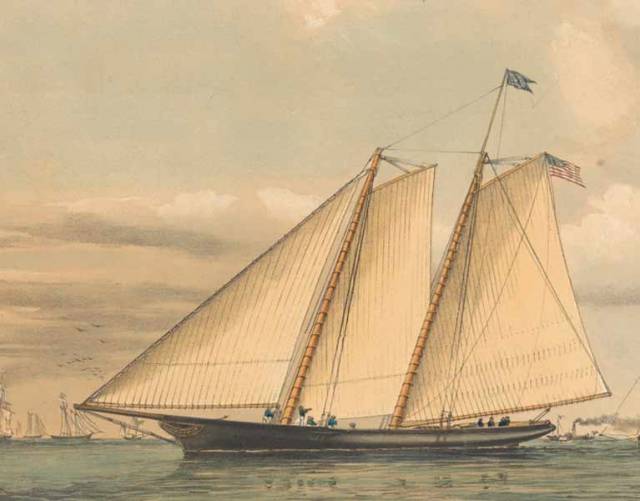There must be very few people in sailing who don’t know something of the America writes W M Nixon. She was the “low black schooner” which came across the Atlantic from New York in 1851, and won a race around the Isle of Wight for the One Hundred Pound Cup against the best that the Royal Yacht Squadron could muster.
The trophy in time became known as the America’s Cup, and thus was inaugurated what we’re told is the world’s longest-established international sporting challenge. Currently held by New Zealand, it has become a Holy Grail of top end sport, raced for by sailing machines at the most advanced (and expensive) level of technology. Yet such is the mystique of the boat which gave the trophy its name that the original America survived until 1945, and today replicas of the 139ft vessel still sail the sea.
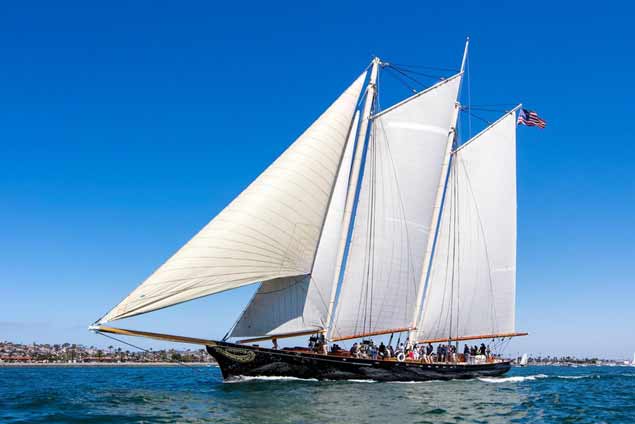 The original rig may have been modified for ease of handling, but America’s hull sails as sweet as ever
The original rig may have been modified for ease of handling, but America’s hull sails as sweet as ever
One of the best-known is in San Diego in California as a living seagoing display at the Maritime Museum. Her presence celebrates the fact that in 1987 the city’s favourite sailing son, Dennis Conner, returned to San Diego with the America’s Cup. The Australians had won it in 1983 from the previously impregnable American retention of 132 years, but the Californian skipper duly took the silver cup back from Australia in 1987, and put San Diego even more firmly on the global sailing map.
Recently, we were exchanging emails with Johnny Smullen, formerly of the National YC but now of San Diego, where his brilliant detail-work boat-building skills have long been associated with Dennis Conner’s remarkable collection of classic yachts. The reason for our email exchange was the success of Bill Trafford of Alchemy Marine in County Cork in winning the of Classic Boat “Spirit of Tradition” award for the extraordinary re-working he did in transforming a very ordinary and rather tired Etchells 22 into the head-turning and immaculately dark blue weekend cruiser Guapa.
This is a project that Johnny is much taken with, and in cheerily signing off, he mentioned that next day, he and the crew of his own beautiful classic Altair - an International One Design - would be transferring their skills aboard the schooner America for the 29th Annual America’s Schooner Race, a noted feature of the San Diego sailing calendar.
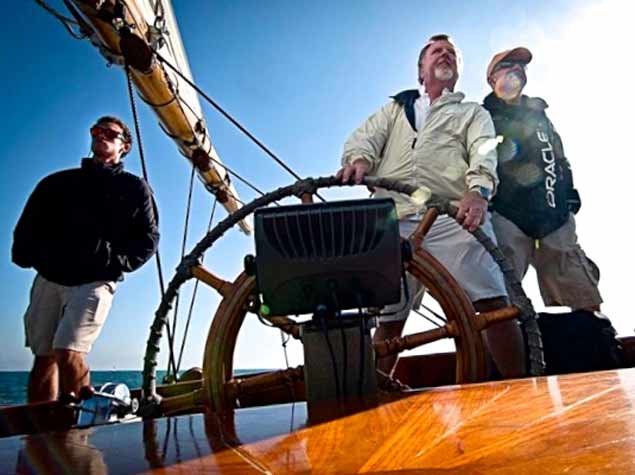 Johnny Smullen of the National YC on America’s helm in San Diego
Johnny Smullen of the National YC on America’s helm in San Diego
While they may not be able to muster the considerable schooner numbers of the glory days of the rig, the presence of the low black schooner America as a competitor is enough to be going along with, while anyone with the smallest drop of sailing blood will be fascinated to know how the America handles, and particularly what she’s like to steer.
For in her day, before new owners (who included two Anglo-Irish landowners) started to change her, America was renowned for her simplicity of rig and lightness on the helm. In fact, it’s said that at one stage she was tiller-steered, and the tiller required was no longer than a broom handle. As for her original rig, it was quintessential mid-19th Century American, with well-raked masts of much the same modest height, a single jib on a boom, and a boomless gaff foresail which overlapped the large mainsail to provide added slot effect. And that was basically it – a topsail above the mainsail appears to have been only there as a light weather sail.
"America was renowned for her simplicity of rig and lightness on the helm"
Under this rig, she had come across the Atlantic with impressive ease. And as for racing, the clockwise circuit of the Isle of Wight may have included only 15 miles of direct beating off the southeast coast of the island, but over those 15 miles the supposedly un-weatherly schooner put more than seven miles between herself and the next yacht, a cutter.
She was simplicity itself, and not unduly cluttered with luxury accommodation, so inevitably her successors – which have corporate entertainment with its necessary comforts ranked high on their programmes – tend to be heavier. And they may have a more easily handled rig, for the original three basic sails were enormous.
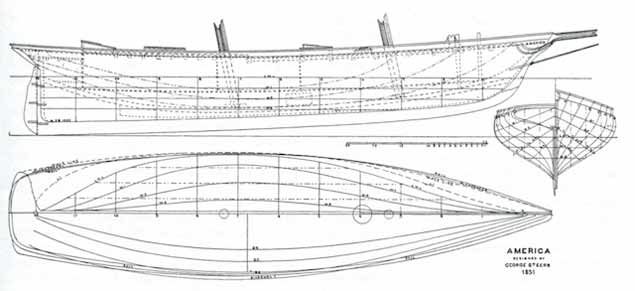 The sweetest lines afloat – thanks to having a vertical rudder and a balanced shape, America is good to sail and steer
The sweetest lines afloat – thanks to having a vertical rudder and a balanced shape, America is good to sail and steer
Nevertheless the spirit lives on, and when we look at her lines we see why she is light on the helm – her rudder is vertical for maximum effectiveness, and though she won’t spin like a top, she is very manageable to steer - as Johnny Smullen tells us, she is really nice to sail, even if the tiller is replaced by a wheel.
But while San Diego’s America always causes a flutter when she puts to sea, the main story in this year’s sailing of the 29th Annual America’s Schooner Race in San Diego was that the winner was the same schooner which won the event at its inauguration nearly 30 years ago, and she’s still being sailed by the same owner and his family.
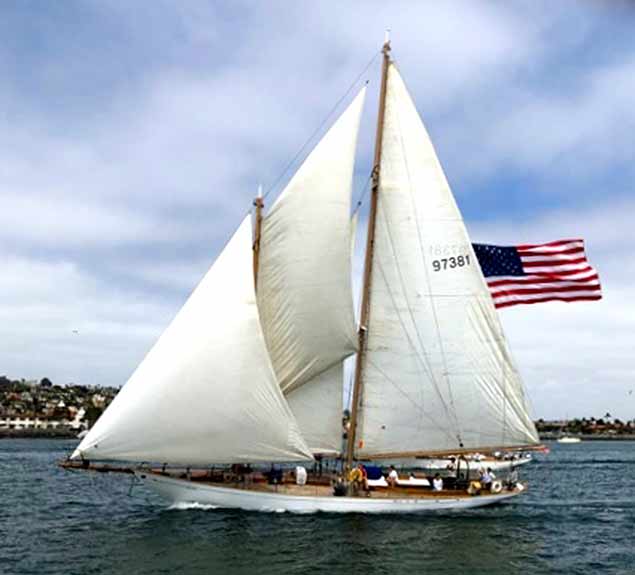 Paul Plott’s 1930-built Alden 61ft schooner Dauntless won the first America’s Schooner Race thirty years ago, and did so again this year. Photo: Johnny Smullen
Paul Plott’s 1930-built Alden 61ft schooner Dauntless won the first America’s Schooner Race thirty years ago, and did so again this year. Photo: Johnny Smullen
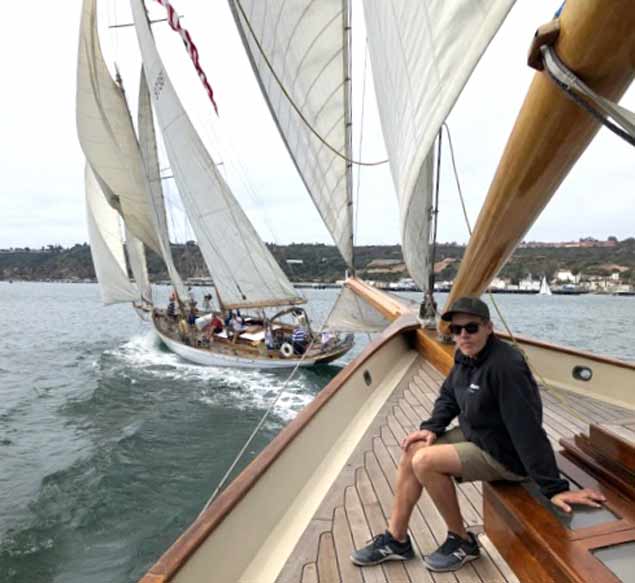 In the light breezes, Dauntless’s huge spread of sail enabled her to nip in ahead of America
In the light breezes, Dauntless’s huge spread of sail enabled her to nip in ahead of America
The 61ft schooner Dauntless is classic John Alden type, built in 1930 with her lines evolved from the great fishing schooners of the Grand Banks. She sets an enormous spread of sail, so in the lightish winds for this year’s race, she was in her element and her owner Paul Plotts was a very popular winner.
But then, at age 91 and with well over thirty years of caring for the often-successfully-raced Dauntless, Paul Plotts is somebody very special. The schooner America can’t have minded being bested by this remarkable combination of boat and skipper.
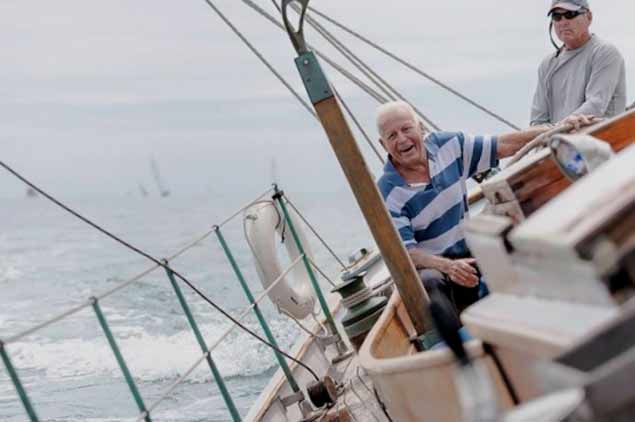 Paul Plotts in great form as he wins with Dauntless nicely in time for his 91st birthday
Paul Plotts in great form as he wins with Dauntless nicely in time for his 91st birthday



























